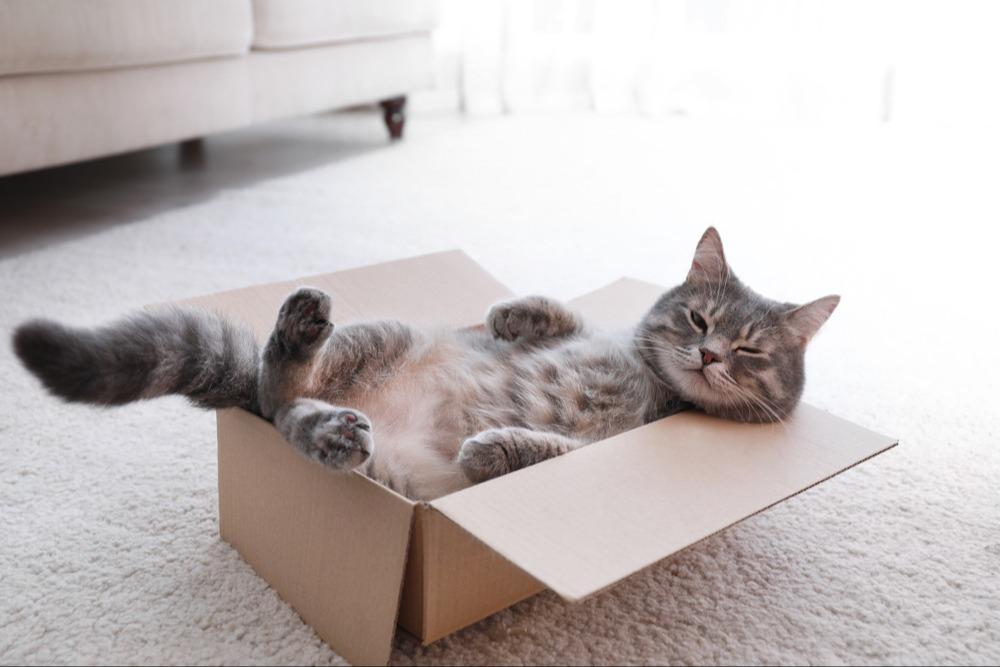
Our feline friends can often be left out when we talk about enrichment for pets – we notice plenty of top tips for our dogs, but sometimes end up a little lost when it comes to our cats. So, how can we enrich our cat’s life?
We’ve popped together some ideas.
Cats have evolved as hunters that consume prey containing high amounts of protein, moderate amounts of fat, and minimal amounts of carbohydrates.
The cat has seemingly evolved as a strict or obligate carnivore; meaning the nutrients they require are found in animal tissue. As such, the consensus is that there is no current nutritional basis for energy to be supplied by carbohydrates; providing other nutrients are being supplied. There is also evidence that there is limited amylase activity in the pancreas and small intestine (even compared to dogs), which may explain why some cats will not tolerate high starch diets.
The fact that cats are also defined as hypercarnivores (small carnivorous mammal with a proportionally large brain) indicates they have a high brain glucose demand. This high demand simply could not be met by carbohydrates present in a natural prey diet; and so, cats therefore have a higher rate of gluconeogenesis (the production of glucose from non-carbohydrate sources).
It is considered that due to the limited intestinal enzyme capacity, consumption of excessive amounts of digestible carbohydrates will not lead to glucose absorption, but rather a substrate for increased microbial fermentation, causing gastrointestinal adverse effects.
In similar tests to dogs, cats are able to target their nutrient intake. When given the choice, they will specifically aim for a high intake of protein. In times of low protein, they will opt for an increased fat intake to achieve balance. When carbohydrate intake was high, this limited intake of other nutrients and resulted in deficits – for that reason, a carbohydrate ceiling was proposed for the cat.
What this means, is that your cat will thrive best on a fresh food diet, high in protein and moderate in fat.
If you find you have a fussy eater, sometimes engaging in play before mealtimes can mimic you cat’s natural prey drive and increase interest in food.
Whenever the body is exposed to something, it must do something with it. In the case of toxic substances, it must make it less toxic, hence the word detoxification (de=remove or reverse).
Detoxification pathways fall into three phases. The first two phases are concerned with breaking down the toxin in the body, and phase three is concerned with excreting it. For us to manage ours and our cat’s toxic load, all three phases need to be working optimally.
Phase one is particularly nutrient demanding, and it produces a lot of reactive oxygen species in the process (those cheeky things that result in oxidative damage which destroys and damages cells). Phase two is also nutrient demanding, but drafts in many different processes depending on the compounds being detoxified.
Phase three deals with getting rid of them once and for all, and occurs in the gut, skin, liver and kidneys. So, it stands to reason that optimal organ function is helpful here.
The issue is that the cat is playing catch up. They aren’t as efficient at these processes as other species, like us, and when we are increasing the toxin burden year on year, it becomes problematic. They have even demonstrated a total inactivation of certain genes responsible for certain phenol detoxification.
So, whilst limited toxin exposure is important for us all, it’s even more important for our cats.
Where possible, limit exposure to:
The Struggle of The Cat in Our Toxic World
Is Your Toxic Home Affecting Your Pet
All cats are different. They have different energy levels and how they behave will depend on their age, breed and past experiences. But there are a few things that we need to ensure for all cats, no matter what.
Cats get stressed. There is no denying that. But they are often a little more subtle in their anxieties than other animals.
As in humans, cats will have the same response to stress. They may choose to fight, flight, or freeze.
When they fight, they become aggressive and defensive. Flight will see them withdrawing from the threat and perhaps running away. When cats freeze, they crouch, lie still, and try to avoid any attention.
There is a ladder of response in most animals, and this is no different in cats. They will often show subtle signs of discomfort or stress. If the trigger doesn’t disappear, the behaviour will progress. You may start with the flat ears, then the pupils will dilate. You may have a low growl or a silent hiss. Them running off or lashing out with their teeth and claws may be a few steps up the ladder.
For some cats, there are triggers which they can’t easily escape from. The most common is a multi-pet home. It is well-established that those cats exposed to dogs report higher stress-hormone levels in their urine. However, some cats have incredible relationships with resident dogs. Generally, if the cat is the first to arrive in the home, the cat-dog relationship will be more comfortable, and indoor cats are more likely to live amicably with dogs, than outdoor cats. Interestingly, it is usually the cat that is the driver of any aggressive encounters with dogs. In short, the cat will call the shots on whether the relationship is harmonious or not.
In a multi-cat home, it is much the same. Some cats cohabit perfectly well, but others may not. Strained relationships can result in excessive grooming, indoor soiling, spraying and even urinary retention, commonly resulting in conditions like cystitis. Cats may also self-soothe by way of sleeping and eating, so they may start to gain unnecessary weight.
One of the ways to help our cats escape or recover in times of stress, is to allow them to hide.
In shelter environments, cats have noted huge reductions in stress-related behaviours in less than 10 days, when they have been allowed to hide. It also didn’t affect their ability to be rehomed.
In short, those cats allowed to hide were less-stressed, more eager to approach strangers and more active.
Cats can hide in:
– Beds
– Boxes
– Under tables
– In wardrobes.
Ensure they are safe spaces, and if you are dealing with a particularly anxious cat, set up plenty of hiding opportunities for them.
How we enrich our cat’s life will depend on their breed, age and past experience, but if you would like any support with your cat’s health, then please check out our services to see how we can help
Thanks for reading,
MPN Team



